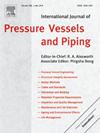80双合金钢焊后热处理:力学与工业安全规范的相容性
IF 3
2区 工程技术
Q2 ENGINEERING, MECHANICAL
International Journal of Pressure Vessels and Piping
Pub Date : 2025-01-07
DOI:10.1016/j.ijpvp.2025.105434
引用次数: 0
摘要
本研究利用原位中子衍射和非原位中子衍射分析了脉冲气体金属弧焊(GMAW-P)调质(Q&;T)双合金80钢在焊后热处理(PWHT)之前、期间和之后的残余应变/应力演变。结果表明,应变/应力松弛主要发生在再加热阶段,松弛率高,斜率陡(应变松弛率约为67%),而在保温(浸泡)阶段则出现线性应变缓解。大部分的应变释放发生在450°C - 600°C的温度范围内,这被认为是由于蠕变应变的发展远远早于部件达到等温保温温度。非原位中子衍射测量结果与原位结果相似,证实施加PWHT有效地减轻了残余应力(最大纵向应力降低到焊缝金属屈服强度的23%左右)。将测量结果与现有文献数据和现行安全评价规范(BS7910和R6)的适应度进行比较。结果表明,两种评估规范对焊缝趾部附近区域的横向和纵向残余应力均较为保守。此外,这两个标准都可能低估了横向上的贯穿厚度残余应力。本文章由计算机程序翻译,如有差异,请以英文原文为准。
Post weld heat treatment of bisalloy 80 steel: Mechanics and industry safety code compatibility
The present study utilized both in-situ and ex-situ neutron diffraction to evaluate the evolution of residual strains/stresses before, during and after Post-Weld Heat Treatment (PWHT) of quenched and tempered (Q&T) Bisalloy 80 steel welded by pulsed Gas Metal Arc Welding (GMAW-P). It was found that strain/stress relaxation mainly occurred during the reheating step with a high relaxation rate and steep slope (∼67 % of strain relaxation) while linear strain relief was observed during holding (soaking) time. Most of the strain relief occurred within the temperature range of 450°C–600 °C which is believed to be due to creep strain development occurring far earlier than the component reaching the isothermal holding temperature. The ex-situ neutron diffraction measurements were similar to in-situ results confirming the applied PWHT effectively mitigated the residual stresses (the maximum longitudinal stress reduced to around 23 % of the weld metal yield strength).
The measurements were compared with existing literature data and the current fitness of safety assessment codes (BS7910 and R6). It was found that both assessment codes were conservative for both the transverse and longitudinal residual stresses in the region close to the weld toe. Furthermore, both standards may underestimate through-thickness residual stresses in the transverse direction.
求助全文
通过发布文献求助,成功后即可免费获取论文全文。
去求助
来源期刊
CiteScore
5.30
自引率
13.30%
发文量
208
审稿时长
17 months
期刊介绍:
Pressure vessel engineering technology is of importance in many branches of industry. This journal publishes the latest research results and related information on all its associated aspects, with particular emphasis on the structural integrity assessment, maintenance and life extension of pressurised process engineering plants.
The anticipated coverage of the International Journal of Pressure Vessels and Piping ranges from simple mass-produced pressure vessels to large custom-built vessels and tanks. Pressure vessels technology is a developing field, and contributions on the following topics will therefore be welcome:
• Pressure vessel engineering
• Structural integrity assessment
• Design methods
• Codes and standards
• Fabrication and welding
• Materials properties requirements
• Inspection and quality management
• Maintenance and life extension
• Ageing and environmental effects
• Life management
Of particular importance are papers covering aspects of significant practical application which could lead to major improvements in economy, reliability and useful life. While most accepted papers represent the results of original applied research, critical reviews of topical interest by world-leading experts will also appear from time to time.
International Journal of Pressure Vessels and Piping is indispensable reading for engineering professionals involved in the energy, petrochemicals, process plant, transport, aerospace and related industries; for manufacturers of pressure vessels and ancillary equipment; and for academics pursuing research in these areas.

 求助内容:
求助内容: 应助结果提醒方式:
应助结果提醒方式:


